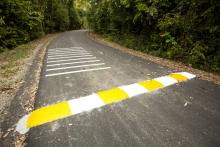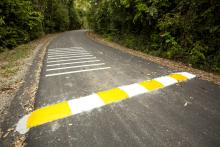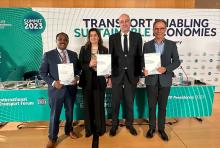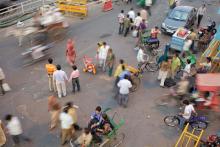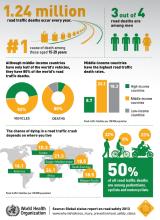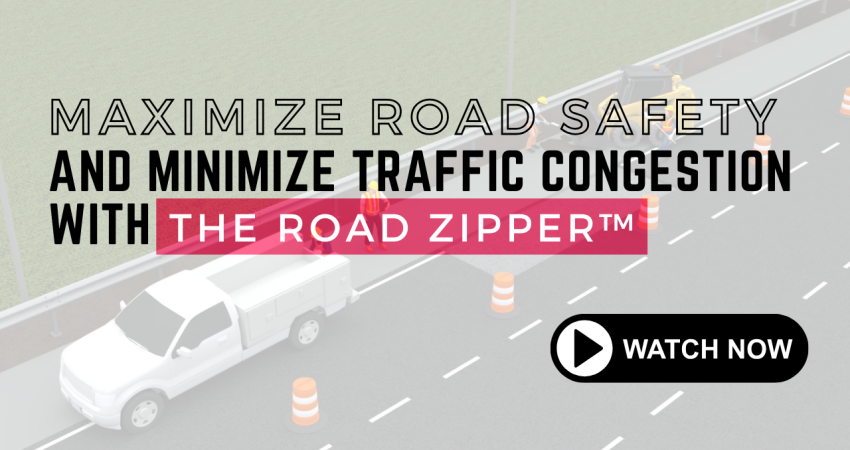Children should have the right of a safe journey to and from school, as part of a wider strategy to build safe, healthy and liveable communities, recommends a new report from UNICEF and the FIA Foundation.
The report, ‘Safe to Learn’, was published to mark the 3rd United Nations Global Road Safety Week, which has a theme of child safety. The report was launched at an event at the World Bank in Washington DC by Zoleka Mandela, a global road safety activist, bereaved mother of a road traffic victim, and gran
Children should have the right of a safe journey to and from school, as part of a wider strategy to build safe, healthy and liveable communities, recommends a new report from UNICEF and the 1341 FIA Foundation.
The report, ‘Safe to Learn’, was published to mark the 3rd3262 United Nations Global Road Safety Week, which has a theme of child safety. The report was launched at an event at the 2332 World Bank in Washington DC by Zoleka Mandela, a global road safety activist, bereaved mother of a road traffic victim, and granddaughter of Nelson Mandela.
Report co-author Avi Silverman, senior adviser to the UNICEF/FIA Foundation Partnership on Road Safety said, “Since the UN Convention of the Rights of the Child was proclaimed 25 years ago, more than 5 million children have died on the world’s roads. This report sets out a strategy, with child rights at its core, for safe access to education and protection on the roads for children everywhere. It’s a strategy ensuring that millions more children do not have to be injured and killed in the years ahead.”
At least 500 children are killed on the world’s roads every day, and thousands more disabled or injured – the equivalent of two Secondary or High Schools being emptied each and every day. While many of these injuries occur away from the school commute, a significant proportion of injury collisions and near misses do occur as children walk, cycle, ride or are driven to and from school. The report argues that a focus on ensuring safe routes to schools is an important first step to building political and community support for wider road safety actions, and particularly for low speed regimes in urban areas where high concentrations of child pedestrians and cyclists interact with motorised traffic.
The UNICEF/FIA Foundation report highlights examples of successful ‘safe to learn’ strategies in high and middle income countries, from the United States to South Korea, where significant investment of hundreds of millions of dollars has shown that streets can be made safer, creating conditions in which walking and cycling to school increases, as child casualties and vehicles speeds drop. Such an approach has multiple social benefits in addition to reducing road traffic injuries: promoting exercise and tackling obesity; playing a role in air quality improvement by reducing car dependence and climate emissions; and enabling stronger and safer communities.
Examples of national strategies in middle and low income countries, as well as demonstration projects that, if taken to scale, could transform both local communities and national mobility strategies and casualty rates are also highlighted. These include: Safe routes to school pilots, speed reduction strategies and advocacy for new traffic legislation in Kenya, supported by Bloomberg Philanthropies. They also include: a national, multi-stakeholder, Child Safety Action Plan in Vietnam, focusing on children riding as passengers on family motorcycles; Local ‘school area assessments’ in low income communities in Tanzania, where up to 4% of children in some schools are injured every year. Others are for: a campaign in Uruguay to legislate for seat belts in all school buses, and to improve quality of car child seats; ‘Star rating’ safety assessments in South Africa which have the potential to reduce risk to children on some school routes by up to 80%.
The ‘Safe to Learn’ report calls for a ‘new global movement to make the school journey safe for all the world’s children’ motivated by a ‘vision of safe streets for all, beginning on the street outside our local school’. The report argues that the anticipated inclusion of a road safety target in the Health Goal of the new Sustainable Development Goals, and the integration of road safety in the Cities Goal, provides an opportunity to build ‘new international cooperative partnerships and programs’ to drive this movement, beginning at the 2nd Global High Level Conference on Road Safety to be hosted by the Government of Brazil in November 2015.
Nicholas Alipui, UNICEF’s director and senior advisor on the Post-2015 Development Agenda said, “We must not measure our development simply in terms of journey times, numbers of vehicles, or length of asphalt. It must be measured in terms of the benefits it brings to society as a whole. We must recalibrate our approach to development, designing a ‘safe system’ for our children. We have the solutions at our fingertips, what’s needed is the policy support, the political will, the prioritisation of our children’s safety.”
Saul Billingsley, FIA Foundation director general, said: “This report is bringing a positive message of hope, of change. We do not accept that so many children should have to walk to school without the protection of pavements or crossings, at the mercy of high speed cars and trucks. We do not believe that parents ferrying children to school in cars because they are too afraid to let them walk because of other parents driving other cars is either rational or environmentally efficient. There is a better way, we want to see our vision of safe streets for all delivered, and the FIA Foundation will be backing up this report with financing, advocacy and partnerships in many countries to help make that happen.”
The ‘Safe to Learn’ joint report has been published by UNICEF and the FIA Foundation as a key part of their partnership work which covers global advocacy and in-country programmatic support. With safe journeys to school as a core focus, the partnership aims to integrate strategies to prevent road traffic injury with UNICEF’s existing priority areas – such as child protection, education, adolescent health and communication for development – and as an emerging Post-2015 priority. Initially, demonstration project work is being developed by the partnership to establish interventions on child road injury prevention.
The report, ‘Safe to Learn’, was published to mark the 3rd
Report co-author Avi Silverman, senior adviser to the UNICEF/FIA Foundation Partnership on Road Safety said, “Since the UN Convention of the Rights of the Child was proclaimed 25 years ago, more than 5 million children have died on the world’s roads. This report sets out a strategy, with child rights at its core, for safe access to education and protection on the roads for children everywhere. It’s a strategy ensuring that millions more children do not have to be injured and killed in the years ahead.”
At least 500 children are killed on the world’s roads every day, and thousands more disabled or injured – the equivalent of two Secondary or High Schools being emptied each and every day. While many of these injuries occur away from the school commute, a significant proportion of injury collisions and near misses do occur as children walk, cycle, ride or are driven to and from school. The report argues that a focus on ensuring safe routes to schools is an important first step to building political and community support for wider road safety actions, and particularly for low speed regimes in urban areas where high concentrations of child pedestrians and cyclists interact with motorised traffic.
The UNICEF/FIA Foundation report highlights examples of successful ‘safe to learn’ strategies in high and middle income countries, from the United States to South Korea, where significant investment of hundreds of millions of dollars has shown that streets can be made safer, creating conditions in which walking and cycling to school increases, as child casualties and vehicles speeds drop. Such an approach has multiple social benefits in addition to reducing road traffic injuries: promoting exercise and tackling obesity; playing a role in air quality improvement by reducing car dependence and climate emissions; and enabling stronger and safer communities.
Examples of national strategies in middle and low income countries, as well as demonstration projects that, if taken to scale, could transform both local communities and national mobility strategies and casualty rates are also highlighted. These include: Safe routes to school pilots, speed reduction strategies and advocacy for new traffic legislation in Kenya, supported by Bloomberg Philanthropies. They also include: a national, multi-stakeholder, Child Safety Action Plan in Vietnam, focusing on children riding as passengers on family motorcycles; Local ‘school area assessments’ in low income communities in Tanzania, where up to 4% of children in some schools are injured every year. Others are for: a campaign in Uruguay to legislate for seat belts in all school buses, and to improve quality of car child seats; ‘Star rating’ safety assessments in South Africa which have the potential to reduce risk to children on some school routes by up to 80%.
The ‘Safe to Learn’ report calls for a ‘new global movement to make the school journey safe for all the world’s children’ motivated by a ‘vision of safe streets for all, beginning on the street outside our local school’. The report argues that the anticipated inclusion of a road safety target in the Health Goal of the new Sustainable Development Goals, and the integration of road safety in the Cities Goal, provides an opportunity to build ‘new international cooperative partnerships and programs’ to drive this movement, beginning at the 2nd Global High Level Conference on Road Safety to be hosted by the Government of Brazil in November 2015.
Nicholas Alipui, UNICEF’s director and senior advisor on the Post-2015 Development Agenda said, “We must not measure our development simply in terms of journey times, numbers of vehicles, or length of asphalt. It must be measured in terms of the benefits it brings to society as a whole. We must recalibrate our approach to development, designing a ‘safe system’ for our children. We have the solutions at our fingertips, what’s needed is the policy support, the political will, the prioritisation of our children’s safety.”
Saul Billingsley, FIA Foundation director general, said: “This report is bringing a positive message of hope, of change. We do not accept that so many children should have to walk to school without the protection of pavements or crossings, at the mercy of high speed cars and trucks. We do not believe that parents ferrying children to school in cars because they are too afraid to let them walk because of other parents driving other cars is either rational or environmentally efficient. There is a better way, we want to see our vision of safe streets for all delivered, and the FIA Foundation will be backing up this report with financing, advocacy and partnerships in many countries to help make that happen.”
The ‘Safe to Learn’ joint report has been published by UNICEF and the FIA Foundation as a key part of their partnership work which covers global advocacy and in-country programmatic support. With safe journeys to school as a core focus, the partnership aims to integrate strategies to prevent road traffic injury with UNICEF’s existing priority areas – such as child protection, education, adolescent health and communication for development – and as an emerging Post-2015 priority. Initially, demonstration project work is being developed by the partnership to establish interventions on child road injury prevention.

